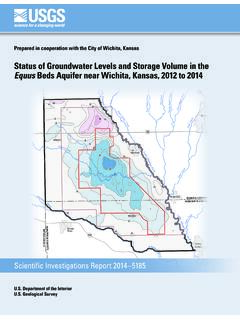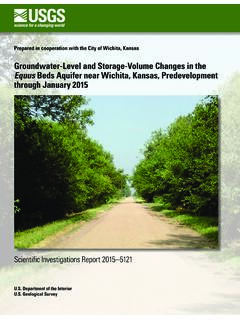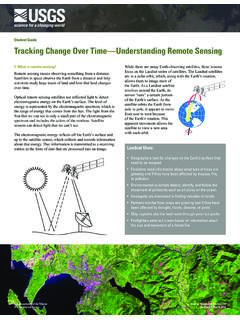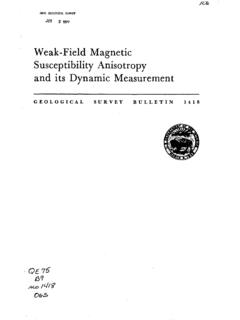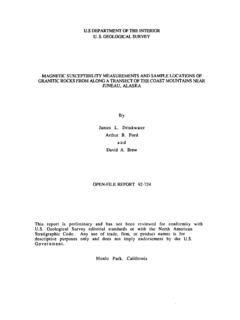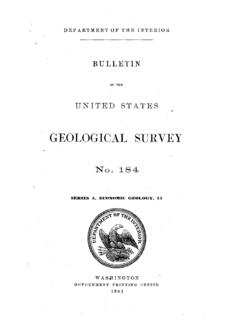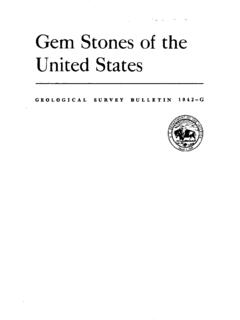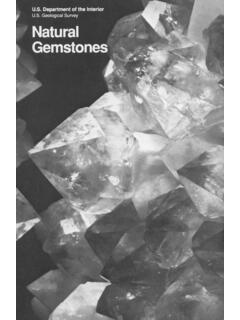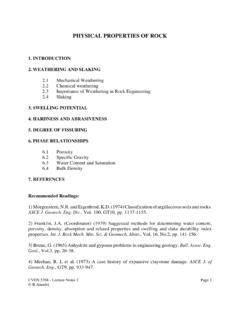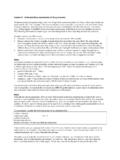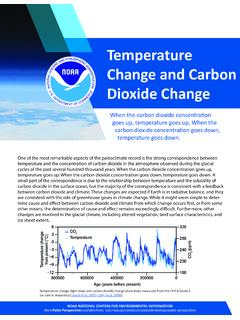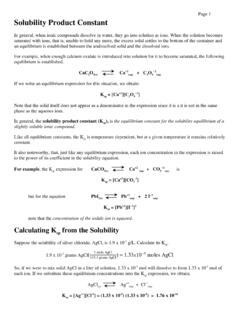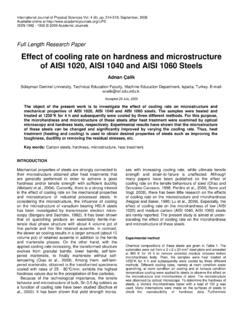Transcription of Form and Stability of Aluminum Hydroxide Complexes in ...
1 Form and Stability of Aluminum Hydroxide Complexes in Dilute Solution GEOLOGICAL SURVEY WATER-SUPPLY PAPER 1827-A. Form and Stability of Aluminum Hydroxide Complexes in Dilute Solution By J. D. HEM and C. E. ROBERSON. CHEMISTRY OF Aluminum IN NATURAL WATER. GEOLOGICAL SURVEY WATER-SUPPLY PAPER 1827-A. Determination of the effect of pH on Aluminum solubility and the determination of the composition of Complexes most likely to occur in natural water UNITED STATES GOVERNMENT PRINTING OFFICE, WASHINGTON : 1967. UNITED STATES DEPARTMENT OF THE INTEFIOR. STEWART L. UDALL, Secretary GEOLOGICAL SURVEY. William T. Pecora, Director For sale by the Superintendent of Documents, Government Printing Office Washington, 20402 - Price 25 cents (paper cover). CONTENTS. Page Abstract_ _ _ _____ Al Purpose and 2. Acknowledgments. _____ 2. Previous 2. Dissolved and suspended _____ 3. Nature of precipitated solids, _-----__-__-_____-_---___-_____ 7. Structures of aqueous Aluminum species_____ 8.
2 Hydrolysis 11. Behavior of anionic Aluminum 15. Behavior of cationic Aluminum 20. Potentiometric 20. Measurement and significance of Aluminum concentrations_____ 23. Filtration 24. Characteristics of filterable 26. Structure of Aluminum Hydroxide polymers. _____ 26. Mechanisms of 32. Verification of polymeric 33. Electron microscopy. 33. Reaction-rate studies_____ 33. Interpretation of results of rate 41. Direct determination of unpolymerized Aluminum . _____ 43. Replacement of Hydroxide by fluoride ions__-_____-___-_-_____ 45. Calculation of Aluminum Hydroxide 46. Calculation of *Ki____---__--_____--____-____--_____--- ___- 48. Factors controlling pH_____ 50. Summary and conclusions. _____ 51. Application to natural 52. Literature 53. in IV CONTENTS. ILLUSTRATIONS. Page FIGURE 1. Schematic representation of hydrolyzed Aluminum ion A1(OH2) 6+3---------------------------------- ------ A10. 2. Schematic representation of dimeric cation A12 (OH) 2 (OH2) 8+*.
3 --___-_____-_____----_--_ 11. 3-7. Graphs showing: 3. Typical titration 15. 4. Observed solubilities of Aluminum anionic species. _ _ 16. 5. Ratio r (COH^CAI^^)) versus pH_-------_____ 21. 6. Decline of pH with time for three solutions _____ 22. 7. Percentage of Aluminum remaining in solut:ons____ 25. 8. Schematic representation of possible linkages of Aluminum Hydroxide dimers_____ 28. 9. Graph showing molar ratio of structural OH to ccmplexed Aluminum . _____ 29. 10. Schematic representation of ring structure formed by six Aluminum Hydroxide 30. 11. Schematic representation of network of Aluminum hydrox- ide octahedra_ ___-------_-_--_--_-_____ 31. 12. Electron photomicrograph of microcrystallinegibbs; 34. 13. Graph showing rate of reaction of freshly formed Aluminum Hydroxide . _____---_----__--___-__-_____-___-__ 37. 14. Graph showing rates of reaction of aged Aluminum hy- droxide. ___--------_--_-_-_---___-____--___-____ _ 38. 15. Graph showing solubility of 47.
4 TABLES. Page TABLE 1. Free energies and Stability A9. 2. Determination of Stability constant for freshly precipitated Aluminum 18. 3. Determination of Stability constant for aged aluminuir hydrox- ide (bayerite)_-_-------_-_-__-__---___-_-__ -_--------- 18. 4. Percentage of Aluminum Hydroxide in filterable state in aged 25. 5. Reaction rates of Aluminum Hydroxide polymer at pH in relation to aging 36. 6. Form of bound Hydroxide deduced from rates of dissolution of Aluminum Hydroxide polymers and related 40. 7. Rapidly reacting Aluminum determined by ferron compared with calculated values for A1+3 and A10H+2 ---__--___------ 43. 8. Computation of *K\, _____ 49. CHEMISTRY OF Aluminum IN NATURAL WATER. FORM AND Stability OF Aluminum Hydroxide . Complexes IN DILUTE SOLUTION. By J. D. HEM and C. E. ROBERSON. ABSTRACT. Laboratory studies of solutions 10~4 to 10~5 molal ( ppm). in Aluminum , in molal sodium perchlorate, were conducted to obtain infor- mation as to the probable behavior of Aluminum in natural water.
5 When the so- lutions were brought to pH and allowed to stand for 24 hours, a precip- itate was obtained which was virtually amorphous as shown by X-rays, and which had a solubility equivalent to that of boehmite. This precipitate had a hydrol- ysis constant (*jK"S4) of When solutions were allowed to str-nd at this pH range for 10 days, their precipitates gave the X-ray pattern of (*X"s4 = 10~ 4). These hydrolysis constants were obtained at 25 C. ard cor- rected to zero ionic strength and are in close agreement with other pul Tished values. The predominant dissolved form in this pH range is A1(OH) 4~. Below neutral pH ( ) the dissolved Aluminum species consist of octahedral units in which each Aluminum ion is surrounded by six water molecules or hy- droxide ions. Single units such as A1(OH2)6+3 and AlOH(OH2)5+2are most abun- dant below pH , and where the molar ratio (r) of combined Hydroxide to total dissolved Aluminum is low. When r is greater than , polymerization of the octahedral units occurs.
6 When r is between and , solutions aged for 10. days or more contained colloidal particles between and p in diameter. Particles whose diameters were greater than M were identified by X-ray dif- fraction as gibbsite. Particles smaller than ^ were also present and were shown by means of the electron microscope to have a hexagonal crystal pattern. Structured material consisting of sheets of coalesced six-membered rings of alu- minum ions held together by double OH bridges has a distinctive kinetic bel avior. This property was used to determine amounts of polymerized material in solutions having r between and after aging times ranging from a few hours to more than 4 months. Aging increased the size and orderliness of the polymeric aggre- gates and was accompanied by a decrease in the pH of the solution. The kinetic experiments and stoichiometric data for solutions aged for long pe- riods provided a means of determining activities of unpolymerized Aluminum .
7 From these values the solubility product for microcrystalline gibbsite was deter- mined to be 33, and its free energy of formation, kcal per mole. Al A2 CHEMISTRY OF Aluminum IN NATURAL WATER. Where polymerization was observed, the process did not stop with small poly- nuclear Complexes containing a few Aluminum ions, but proceeded with aging until macromolecules or colloidal-sized particles were formed. PURPOSE AND SCOPE. Aluminum is an abundant constituent of rock minerals; in fact, only oxygen and silicon exceed Aluminum in abundance among the elements present in the outer part of the earth's crust. Aluminum is, however, a very minor dissolved constituent in natural water. In routine water analyses the element is seldom determined, but the available information shows that, except for waters having a pH below , concentrations rarely exceed a few tenths of a part per million. The chemistry of Aluminum in rock-weathering processes seems to favor retention of the element in solids with low solubilities, especially in clay minerals.
8 Aluminum has a particularly strong tendency to hydrolize in solution, and at any pH above various combinations of Aluminum with Hydroxide ions occur. The purpose of this investigation was to determine the effect of pH. on Aluminum solubility and to determine the composition of Aluminum Hydroxide Complexes that are most likely to occur in solution or suspension in natural water. The equilibrium Stability of these species, their geometric configuration, and the kinetics of reactions in which they are destroyed were also considered. ACKNOWLEDGMENTS. During this investigation the many discussions held with colleagues in the Geological Survey and with others having an interest in the chemistry of Aluminum aided in forming the conclusions expressed here. Ivan Barnes and Robert Schoen, of the Geological Survey, and Dr. George A. Parks, of Stanford University, reviewed the manu- script. Robert Heidel, of the Geological Survey, aided in the electron-microscope studies.
9 PREVIOUS STUDIES. The solubility of Aluminum Hydroxide in water and the form and Stability of solute species containing Aluminum and Hydroxide have been the subject of many research studies from early in the 20th century to the present. The Stability constants published prior to 1961 are included in the compilation of Stability constants by Sillen and Martell (1964). The published work was reviewed care- fully, with particular attention to the studies completed in the past 10-15 years, to provide background information and to aic1 in planning this investigation. Aluminum Hydroxide Complexes A3. The results of previous investigations suggest that several different forms of dissolved Aluminum species might be expected over the pH. range most prevalent in natural waters. Stability constants reported for these species cover a rather wide range of values. The published standard free-energy values for the common solid forms of Aluminum Hydroxide also disagree.
10 The chemical behavior of Aluminum in dilute solutions presents some serious experimental difficulties. Most reactions involving Aluminum and Hydroxide proceed slowly at 25 C. Metastable solid species occur and equilibrium conditions are difficult to attain even when long periods of time have been allowed for reactions to proceed. In many reported experiments, equilibrium probably was not ob- tained. Solid Aluminum oxides and hydroxides form a number of of crystalline structures that are chemically similar but differ in solubility ; not all investigations ascertained the nature of the solids involved. Experimental conditions temperature, concentration, and even rate of addition of reagents strongly influence the results. The accuracy of analytical methods for determining low concentrations of Aluminum is not particularly good (below ppm, or <4X10~5. molar). Furthermore, Aluminum Hydroxide tends to form colloidal or subcolloidal suspensions that are difficult to describe thermo- dynamically.
